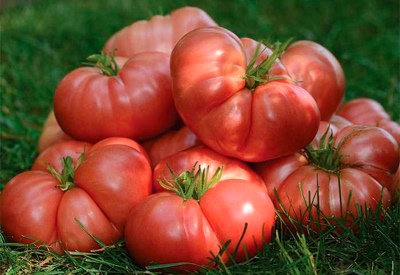
- Authors: Khovrin A. N., Maksimov S. V., Tereshonkova T. A., Kostenko A. N. LLC 'Agrofirma Poisk'
- Year of approval: 2015
- Category: grade
- Growth type: indeterminate
- Appointment: fresh consumption
- Ripening period: mid-season
- Ripening time, days: 115-120
- Growing conditions: for film greenhouses
- Bush size: tall
- Bush height, cm: more than 150
The mid-ripening indeterminate variety Brandy pink is cultivated throughout Russia: from the southern regions to Siberia. The tomato grows well both in the open field and in the conditions of film and polycarbonate greenhouses, it is distinguished by its unpretentiousness, endurance, decorative color and delicate taste. The fruits are intended primarily for fresh consumption and in the form of summer salads. It is used less often for canning, since the pink color in sauces looks too pale and requires the addition of varieties with a more intense color.
Breeding history
The appearance of the pink handsome man in the vastness of Russia was ensured by Agrofirma Poisk LLC and breeders A. N, Khovrin, S. V. Maksimov, T. A. Tereshonkova, A. N. Kostenko. Registration in the State Register took place in 2015.
Description of the variety
Tall, moderately leafy bushes reach 150 cm or more, so the tomato needs to form and pinch the growing point. Shoots are covered with small green leaves. Yellow flowers are collected in simple inflorescences, the first is formed over the 8th leaf, all subsequent ones in 2-3 nodes. On each brush, 3-4 fruits are tied, each of which is attached to an articulated stalk.
The main qualities of the fruit
The fruits are large, flat-rounded, medium-silvery, covered with a thin delicate skin; at the stage of technical ripeness, tomatoes are painted in beautiful pink-scarlet tones. Fruit weight 250-450 g, multi-chamber pulp of medium density has a small number of seeds.
Taste characteristics
Brandy pink is distinguished by a delicate balanced dessert taste, combining sweetness and a slight hint of sourness.
Ripening and fruiting
The variety belongs to the mid-ripening category - the ripening period is 115-120 days, the harvest begins in July-August.
Yield
Brandy pink has consistently high yields - 6.6 kg per square meter.
The timing of planting seedlings and planting in the ground
Seeds for seedlings are sown in March, young plants are planted in the ground in May-June, depending on the growing conditions (greenhouse or open ground).

Growing tomato seedlings is an extremely important process, because it largely depends on whether the gardener will be able to harvest at all. All aspects must be taken into account, from seedbed preparation to planting in the ground.
Landing scheme
According to agrotechnical requirements, the distance between the roots should be 40 cm, between the rows 60 cm.

Growing and care
Seedling cultivation, when planting in a permanent place is carried out 55-60 days after germination.For growing seedlings, loose air-permeable mixtures with a neutral pH and balanced nutrient content are used. It is easier to use ready-made soil mixtures bought in specialized stores, although experienced gardeners prepare them themselves.
Seedlings necessarily dive at the stage of 2-3 true leaves, transplanting them into seedling boxes or glasses, and the latter method is much more effective. Juveniles with a closed root system endure the change of conditions almost painlessly. In the first 1.5-2 weeks after planting the young in the garden, it must be protected from the scorching sun rays - burns can destroy immature seedlings almost as guaranteed as frost.
For planting in the ground, the soil is pre-dug up with the simultaneous introduction of organic matter and mineral fertilizers. Tall bushes need support and tying, organizing trellises or installing stakes in ridges. Plants are planted after the threat of return frosts has passed, and the soil warms up to + 15 ... 17 degrees. Further care for the variety consists in regular watering, weeding, loosening the soil, and top dressing. The plant is formed into 1-2 stems for a good harvest. Mulching replaces loosening with great success, helps to retain moisture and prevents the soil from drying out and cracking.
The application of mineral and organic fertilizers is carried out at least three times per season. The first feeding after planting is carried out 2-3 weeks later, when the plant needs nitrogen to build up the vegetative mass. The second mandatory stage is the period of budding and ovary formation. At this time, tomatoes need phosphorus-potassium fertilizers. Brandy pink responds extremely well to watering with infusion of nettle and other green herbs, good fertilizer from a settled solution of fresh mullein, watering is done at the rate of 0.5 liters per bucket of water. Watering is required before the start of the fruit pouring, otherwise the plant begins to weaken, shedding color in order to stretch the already formed ovary. Growing in a greenhouse requires mandatory measures for airing and breaking off the lower leaves in order to avoid excess moisture and the appearance of late blight.




A plant needs different micronutrients at each stage of growth. All fertilizers can be divided into two groups: mineral and organic. Folk remedies are often used: iodine, yeast, bird droppings, eggshells.
It is important to observe the rate and period of feeding. This also applies to folk remedies and organic fertilizers.
Disease and pest resistance
According to the declared characteristics, the tomato has good resistance to tobacco mosaic (TM).Since nothing is said about the other numerous diseases characteristic of nightshades, preventive treatments of plants with fungicides, as well as insecticides, are required.


Resistant to adverse weather conditions
The variety tolerates adverse conditions well - temperature drops, dry or rainy periods.
Growing regions
Tomato Brandy pink is adapted for cultivation in such regions of the country as the North, North-West, Central, Volgo-Vyatka, TsChO, North Caucasian, Middle Volga, Nizhnevolzhsky, Ural, West Siberian, East Siberian, Far Eastern regions.

























































































